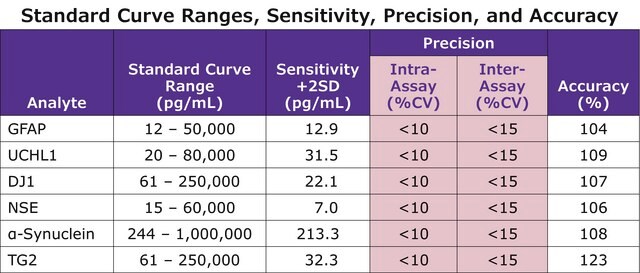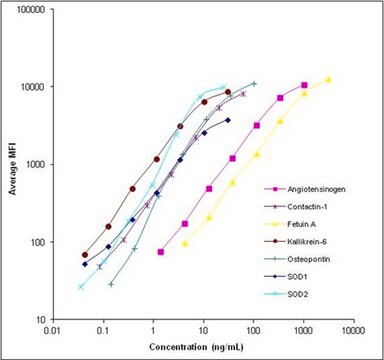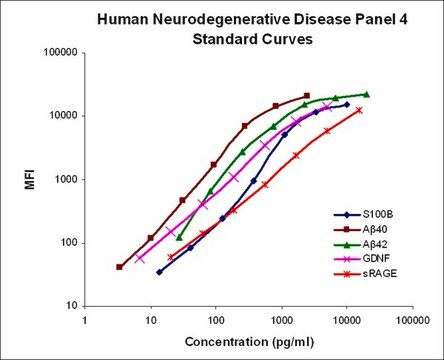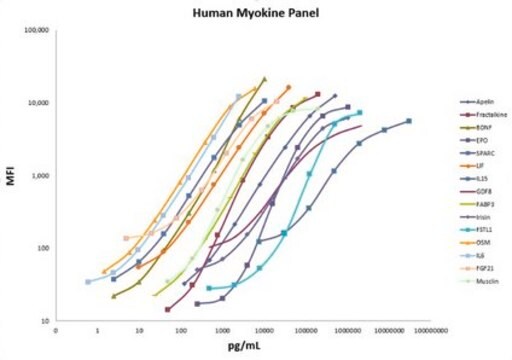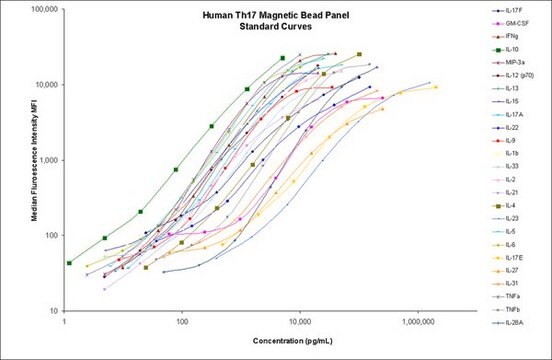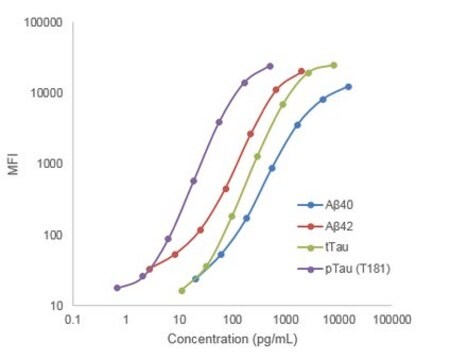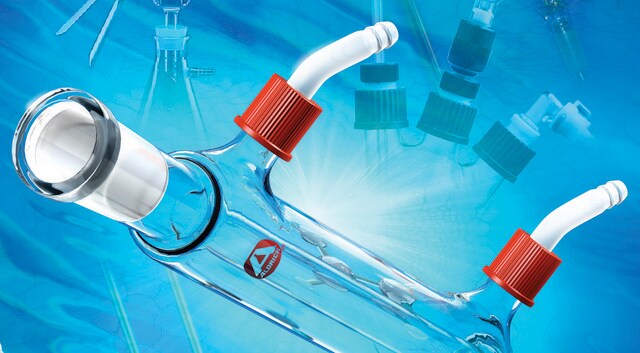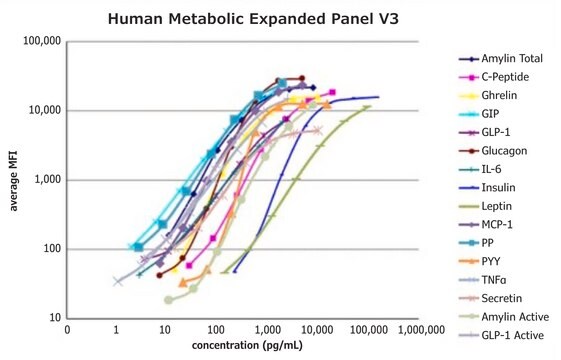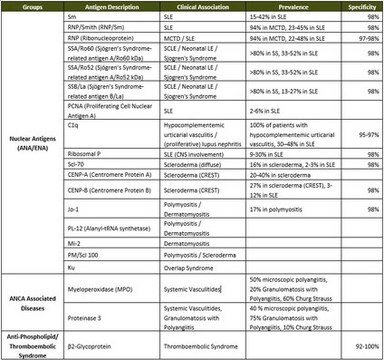HNS2MAG-95K
MILLIPLEX® Human Neuroscience Magnetic Bead Panel 2 - Neuroscience Multiplex Assay
The analytes available for this multiplex kit are: Angiogenin, ApoE4, FABP3, Ferritin, Neurogranin, and TREM2.
About This Item
Polecane produkty
reaktywność gatunkowa
human
producent / nazwa handlowa
Milliplex®
assay range
accuracy: 124%
(Neurogranin)
accuracy: 84%
(FABP3)
accuracy: 85%
(ApoE4)
accuracy: 94%
(TREM2)
accuracy: 97%
(Angiogenin)
sensitivity: 11.0 pg/mL
(MinDC + 2SD; TREM2)
sensitivity: 14.3 pg/mL
(MinDC + 2SD; FABP3)
sensitivity: 162.8 pg/mL
(MinDC + 2SD; ApoE4)
sensitivity: 19.9 pg/mL
(MinDC + 2SD; Neurogranin)
sensitivity: 5.8 pg/mL
(MinDC + 2SD; Angiogenin)
sensitivity: 6.1 pg/mL
(MinDC + 2SD; Ferritin)
standard curve range: 15-50,000 pg/mL
(TREM2)
standard curve range: 2-10,000 pg/mL
(Angiogenin)
standard curve range: 24-100,000 pg/mL
(FABP3)
standard curve range: 244-1,000,000 pg/mL
(ApoE4)
standard curve range: 5-20,000 pg/mL
(Neurogranin)
standard curve range: 6-25,000 pg/mL
(Ferritin)
inter-assay cv: <10%
intra-assay cv: <5%
(Angiogenin)
inter-assay cv: <10%
intra-assay cv: <5%
(FABP3)
inter-assay cv: <10%
intra-assay cv: <5%
(TREM2)
inter-assay cv: <15%
intra-assay cv: <10%
(Ferritin)
inter-assay cv: <15%
intra-assay cv: <10%
(Neurogranin)
inter-assay cv: <15%
intra-assay cv: <5%
(ApoE4)
metody
multiplexing: suitable
metoda wykrywania
fluorometric (Luminex xMAP)
Opis ogólny
MILLIPLEX® Human Neuroscience Bead Panel 2 is a 6-plex kit to be used for the simultaneous quantification of any or all of the following analytes in cerebrospinal fluid (CSF), serum/plasma and cell/tissue culture supernatants for homogenates: Angiogenin, ApoE4, FABP3, Ferritin, Neurogranin, TREM2.
Panel Type: Neuroscience
Specyficzność
Cross-reactivity between the antibodies and any of the other analytes in this panel is non-detectable or negligible. There is <5% cross-reactivity from ApoE2 and ApoE3 recombinant proteins on the ApoE4 beads.
Zastosowanie
- Analytes: Angiogenin, ApoE4, FABP3, Ferritin, Neurogranin, TREM2
- Recommended Sample type: Plasma, Serum, CSF, Cell/Tissue culture supernatant
- For Plasma/Serum a 1:10 dilution is recommended for the optimal detection of the analytes FABP3, Ferritin, Neurogranin and TREM2.
- For Plasma/Serum a 1:200 dilution for ApoE4 and Angiogenin is recommended.
- Because the sample dilutions differ for Plasma/Serum samples ApoE4 and Angiogenin cannot be plexed in the same assay as FABP3, Ferritin, Neurogranin and TREM2.
- CSF samples require a 1:10 dilution and so may all be plexed together
- Cell/Tissue culture supernatants or homogenates may be used neat or diluted in appropriate control medium.
- Bead diluent must be present in order to detect Angiogenin. (Biotinylated-Angiogenin detection antibody is included in the bead diluent.)
- Research Category: Neuroscience
Cechy i korzyści
Opakowanie
Przechowywanie i stabilność
Informacje prawne
Oświadczenie o zrzeczeniu się odpowiedzialności
Hasło ostrzegawcze
Danger
Zwroty wskazujące rodzaj zagrożenia
Zwroty wskazujące środki ostrożności
Klasyfikacja zagrożeń
Acute Tox. 3 Dermal - Acute Tox. 4 Inhalation - Acute Tox. 4 Oral - Aquatic Chronic 2 - Eye Irrit. 2 - Skin Sens. 1
Kod klasy składowania
6.1C - Combustible acute toxic Cat.3 / toxic compounds or compounds which causing chronic effects
Certyfikaty analizy (CoA)
Poszukaj Certyfikaty analizy (CoA), wpisując numer partii/serii produktów. Numery serii i partii można znaleźć na etykiecie produktu po słowach „seria” lub „partia”.
Masz już ten produkt?
Dokumenty związane z niedawno zakupionymi produktami zostały zamieszczone w Bibliotece dokumentów.
Powiązane treści
Learn how to integrate multiplex and high sensitivity immunoassay technology to further neuroscience research with MILLIPLEX® multiplex and Single Molecule Counting (SMC®) high sensitivity immunoassay detection of Alzheimer’s disease (AD) biomarkers in human cerebrospinal fluid, plasma, and serum samples.
Usprawnij badania dzięki końcówkom do multipleksowania MILLIPLEX®, wskazówkom branżowym i jednodniowym testom w ograniczonym czasie laboratoryjnym.
Uncover tips and tricks to multiplexing in this guide from the experts. Learn how you can enhance the power of your research with MILLIPLEX® multiplexing, including industry guidance for immunoassays, multiplexing tips, one-day MILLIPLEX® multiplex assays for limited lab time, and more.
Odkryj zalety testów multipleksowych MILLIPLEX®, opartych na technologii testów multipleksowych Luminex® xMAP®, które zapewniają spójne, wysokiej jakości wyniki i zobacz, w jaki sposób te multipleksowe testy biomarkerów Luminex® są wykorzystywane do postępu badań.
Nasz zespół naukowców ma doświadczenie we wszystkich obszarach badań, w tym w naukach przyrodniczych, materiałoznawstwie, syntezie chemicznej, chromatografii, analityce i wielu innych dziedzinach.
Skontaktuj się z zespołem ds. pomocy technicznej